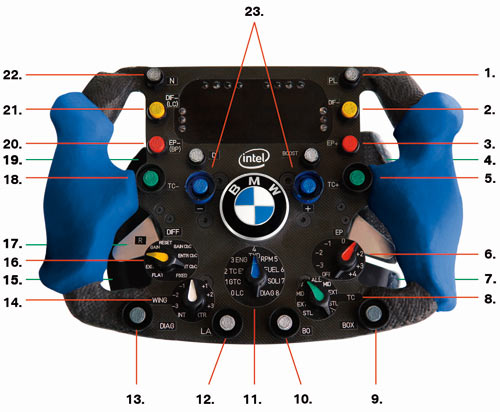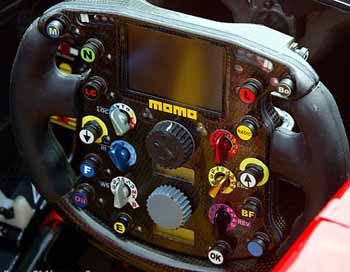History steering

As recently as 1992, the steering wheel on a Formula 1 car was a relatively plain, straightforward piece of equipment, round in shape, with a metal plate at the centre to attach it to the steering column, and generally no more than three buttons – one for selecting neutral, one for releasing liquid through a tube in the helmet for the driver to replenish his fluid levels and one for the radio.
The advent of complex electronic systems in Formula 1 throughout the 1990s changed all that. McLaren engineer John Barnard was the first to introduce this system and enabled Nigel Mansell to shift gears without having to move a hand away from the steering wheel. It was introduced as a lever system at the back of the steering wheel. A pull on the left paddle will shift one gear down while the right paddle shifts up in a similar way. This eliminates the possibility of a driver missing a gear, therefore increasing the smoothness and improving the timing of gearshifts. Together with the introduction of semi-automatic gearboxes, this was one of the most changing introductions in the history of Formula One, especially on the driver's side. Later on, when left foot braking was introduced into Formula One, the clutch pedal was removed and replaced by a fully automatic hydraulic clutch, activated when the driver shifts gears on the steering wheel.
Engine mapping, traction control and the advent of launch control programs that optimised the race start procedure all required various buttons and toggle switches to enable the driver to fine-tune his car’s settings while on-track. Modern Formula 1 steering wheels are also equipped with a further lever clutch lever which the driver can use to declutch when standing still, such as during a pitstop or in the gravel to keep the engine running.
Construction
Today, a steering wheel is a complex electronic device that allows the driver to control a vast amount of carsettings. The teams often assign one engineer that is responsible for its electronics and the design so that the drivers can use it comfortably. For that reason, today's handles of a steering wheel are anatomically formed and made of hard rubber that provides extra grip for the driver's hands. The main part of the wheel however is constructed, just like almost every car part, of carbon fibre to reduce its weight. The pieces used today have a pricetag of around € 23.000 each.
The manufacture of any part on a Formula 1 car is a complex process, and the steering wheel is no exception. Various lightweight materials are used for its production, including the before mentioned carbon fibre and rubber with aluminium, titanium, steel and plastic. A complete steering wheel can take approximately 100 hours to produce from start to finish.
With the average steering wheel controlling as many as 12 separate parameters on the car, there is a large number of components, buttons and switches that have to be fitted during the manufacturing process – some 120 separate items in all. Yet, despite the myriad of materials and parts that make up each completed wheel, the weight of the finished unit, as fitted to the car, is just 1.3 kg.
During the season, a minimum of five steering wheels is constructed for each of the team’s two race drivers. Of these, three remain with the race team while two are held with the test team. In addition, on average two steering wheels have to be produced for each regular testdriver. Some teams, despite the cost of a steering wheel, remove the steering wheel from the car after a race win to put it in the team's collection as a memory to the win.
As imposed by FIA regulations, the steering wheel must be fitted with a quick release mechanism operated by pulling a concentric flange installed on the steering column behind the wheel.
The BMW Sauber 2006 steering wheel

| 1. Pit lane speed limiter 2. Differential + 3. Engine push 4. Gear upshift 5. Traction control + 6. Engine push setting switch 7. Clutch lever 8. Traction control 9. Team info inlap 10. Burn out 11. Multifunctional switch 12. Lambda | 13. Diagnostic 14. Wing angle info switch 15. Clutch 16. Differential selective switch 17. Team radio 18. Traction control - 19. Gear downshift 20. Engine break 21. Differential - 22. Neutral 23. Display page change |
Ferrari 2002 steering wheel
After some time of consistency, the Ferrari steering wheel has been changed again at the beginning of the 2002 season and remained like that for the next couple of years.

It's main buttons allow the driver to do the following:
- The big display in the center-top display all the information you can image: engine revs, laptimes, speed, gear, ...
- The green-black button N to put the gearbox in neutral
- The black-red LC button, to change setting of the launch control
- The red-black L button, to apply the speed limiter in the pit lane
- The yellow button radio is a switch for the onboard radio
- Buttons M and Bo on the top are multifunctional buttons for display adjustments
- The blue rotating button is to adjust the fuel-air mix in the engine
- The button under air-fuel allows the driver to regulate the braking pressure on the front and rear wheels
- The button above air-fuel permits adjustments to the power steering
- The 3 rotating buttons on the right are all for engine adjustments


No comments:
Post a Comment